The 1957 nickel is part of the Jefferson nickel series that was struck by the United States Mint in 1957. As a coin that is over 65 years old, the 1957 nickel can bring a lot of great memories. It can also serve as a gift or a piece of memorabilia.
Whatever reason you might have that you’re interested in 1957 nickel, this article will help you know more about its composition, design, history, and value. Read on to learn more!
What Is the 1957 Jefferson Nickel Made Of?
One of the most important and common questions people have when it comes to coins is about their composition. The 1957 Jefferson nickel contains 75% copper and 25% nickel. It has a weight of 5 grams, a diameter of 21.20 millimeters, and a plain edge.
It’s worth noting that the Jefferson nickel wasn’t always made of copper and nickel. During World War II, the nickel coin was made of 9% manganese, 35% silver, and 56% copper in an effort to conserve nickel. Nickel at that time was a necessary raw material in producing bullets, armaments, and other important war equipment.
The design features the face of Thomas Jefferson, the third President of the United States and also considered to be a founding father of the nation. The original design was prepared by Felix Schlag. Although today, the obverse was changed by a design made by Jamie Franki. The reverse essentially remained the same up to this day.
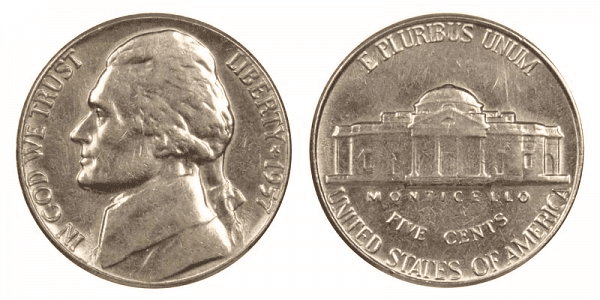
The obverse of the 1957 50-cent coin has the picture of Thomas Jefferson facing to the left. Inscriptions include IN GOD WE TRUST, LIBERTY, and 1957.
On the reverse, you’ll find the front view of Monticello, which is the home of Jefferson. Inscriptions include E PLURIBUS UNUM, MONTICELLO, FIVE CENT, and UNITED STATES OF AMERICA.
The Jefferson nickel was first struck in 1938. It replaced the Buffalo nickel, which was nice but difficult to mint.
The Jefferson nickel was divided into two: the Vintage, which includes the nickels from 1938 to 1964 and Modern, which includes the nickels from 1965 to 2003. It should be remembered that 1964 was the last year when nickel was made with silver. So, it’s a nice demarcation mark for categorizing the Jefferson nickel.
1957 Jefferson Nickel Varieties
The 1957 Jefferson nickel includes three varieties. In terms of design, the 1957 Jefferson varieties don’t differ much from each other. The main difference is their mint mark and whether they are made as proof or not.
Here’s a quick look at the 1957 Jefferson nickel varieties:
| Variety | Mint Location | Mintage |
| 1957 D Jefferson Nickel | Denver | 136,828,900 |
| 1957 P Jefferson Nickel | Philadelphia | 38,400,000 |
| 1957 P Proof Jefferson Nickel | Philadelphia | 1,247,952 |
| Total | 125,862,300 |
The San Francisco Mint was closed during this time and thus, it didn’t produce any nickels in 1957. Plus, the Denver and Philadelphia Mint centers were producing enough nickels to meet the demand.
Let’s have a deeper look at each of these varieties to learn more about them.
1957 D Jefferson Nickel
Year of minting: 1957
Mint Mark: D
Place of minting: Denver
Quantity produced: 136,828,900
Face Value: $0.05 (five cents)
Price: $0.10 to $0.20 (circulated condition)
Mass: 5.00 grams
Diameter: 21.20 millimeters
Edge: Plain
Designer: Felix Schlag
Composition: 75% Copper, 25% Nickel
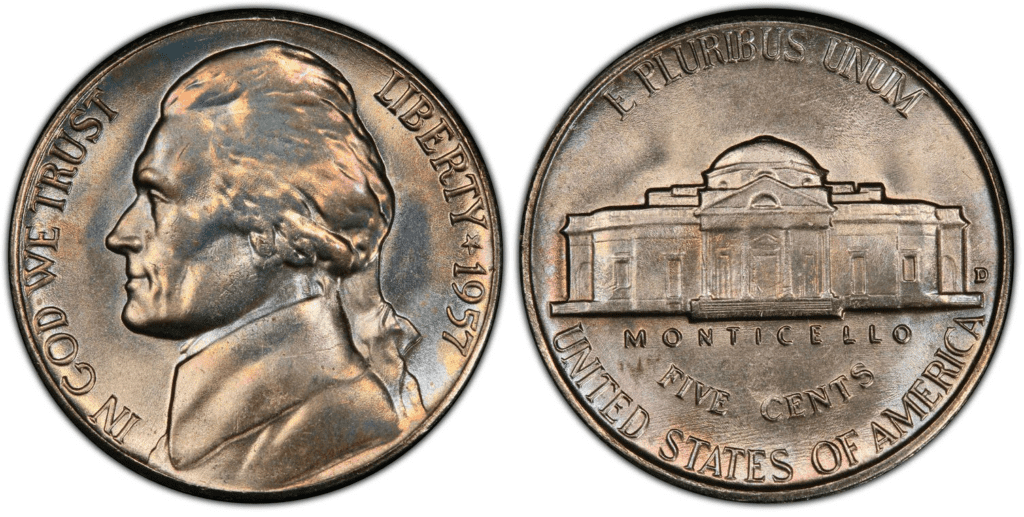
The Denver Mint produced a lot of 1957 nickels to the point that they produced the most number of nickels for that year.
1957 P Jefferson Nickel
Year of minting: 1957
Mint Mark: none
Place of minting: Philadelphia
Quantity produced: 38,400,000
Face Value: $0.05 (five cents)
Price: $0.10 to $0.20 (circulated condition)
Mass: 5.00 grams
Diameter: 21.20 millimeters
Edge: Plain
Designer: Felix Schlag
Composition: 75% Copper, 25% Nickel
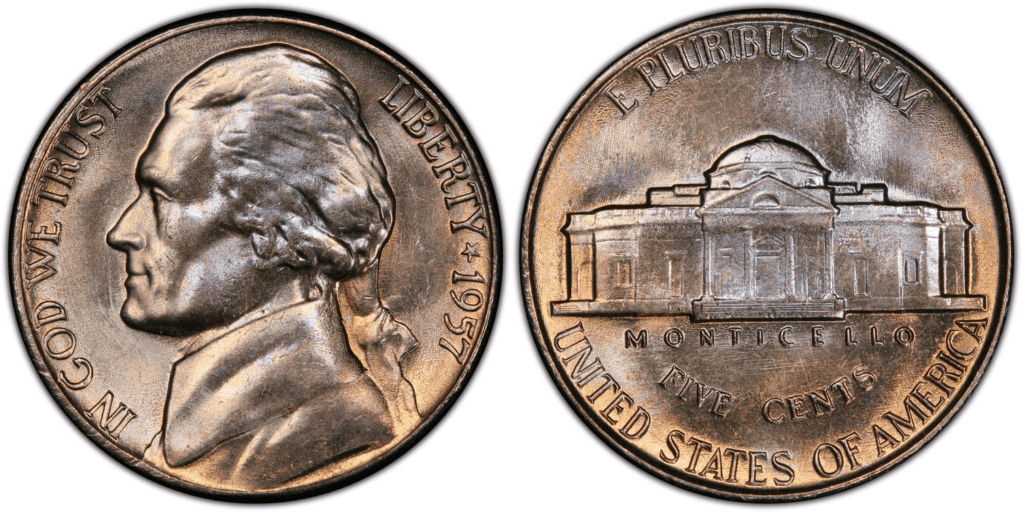
The Philadelphia Mint produced more than 38 million nickels in 1957. If you plan to sell your 1957 nickel or buy one, expect that the price may start at around $0.10 to $0.20 for coins in circulated condition.
1957 Proof Jefferson Nickel
Year of minting: 1957
Mint Mark: none
Place of minting: Philadelphia
Quantity produced: 1,247,952
Face Value: $0.05 (five cents)
Price: $7 (uncirculated condition)
Mass: 5.00 grams
Diameter: 21.20 millimeters
Edge: Plain
Designer: Felix Schlag
Composition: 75% Copper, 25% Nickel
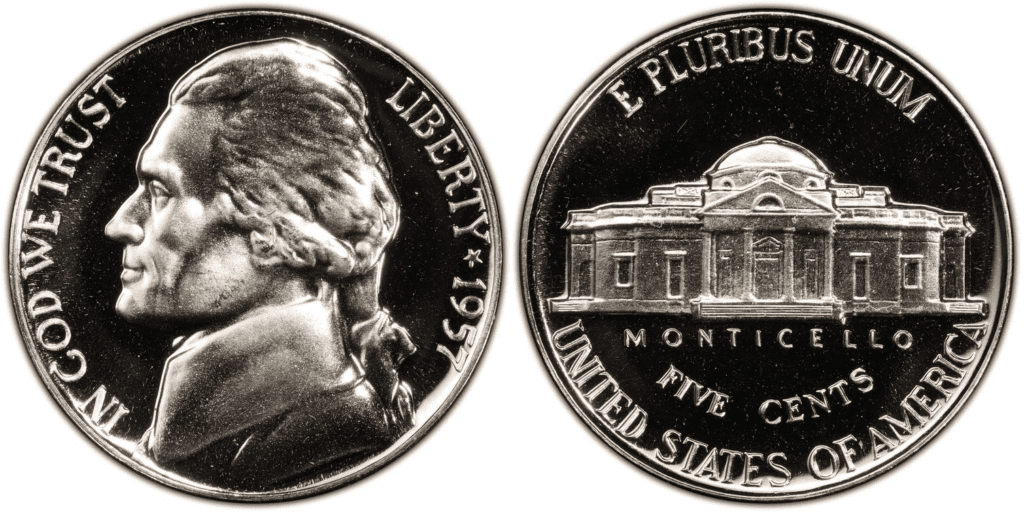
There was a big demand for proof nickels in 1957. The demand was big enough that the production of proof coins exceed 1 million.
Proof coins are special types of coins because they are not made for circulation but rather for collectors. Proof coins are more beautiful in appearance because they are manually polished, cleaned, and prepared. More time and energy are needed in producing them.
List Of 1957 Jefferson Nickel Errors
The 1957 Jefferson nickels aren’t exempted from errors. While error coins aren’t something that the US Mint want to have, they can be valuable in the eyes of collectors. So, they are actually interesting coins to have on your shelf.
Here are some examples of 1957 Jefferson nickel error coins.
Worn die error
The die should have a detailed surface to ensure it gives a coin its detailed look as well. However, due to wear and tear, a die can lose some of its surfaces. So when it hits the planchet, it won’t give a detailed look to the coin.
Here’s an example of a worn die error on a 1957 Jefferson nickel:
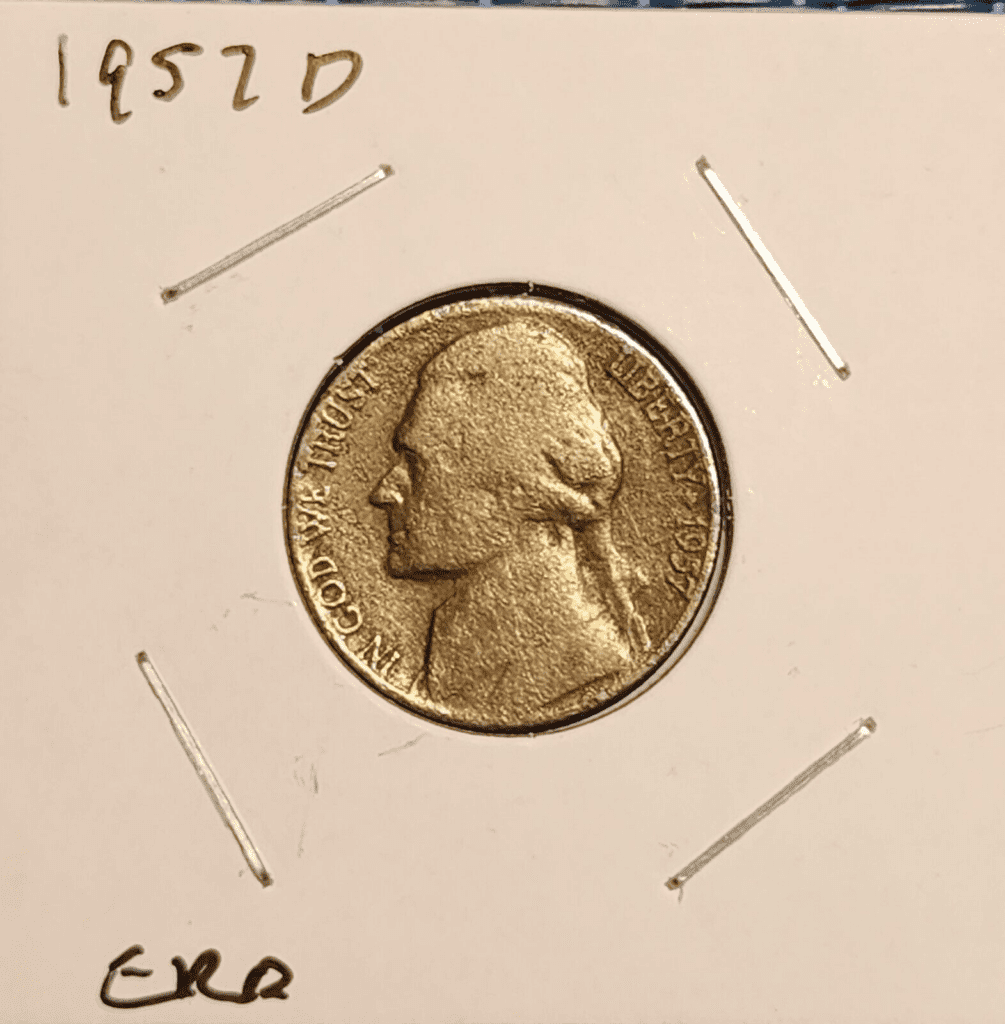
Clipped planchet error
Not all errors happen during the die strike. It can also happen during the cutting of the planchet. Due to misalignment in feeding the metal sheet for the coins, a clipped planchet error may happen.
Here’s an example of a clipped planchet error:
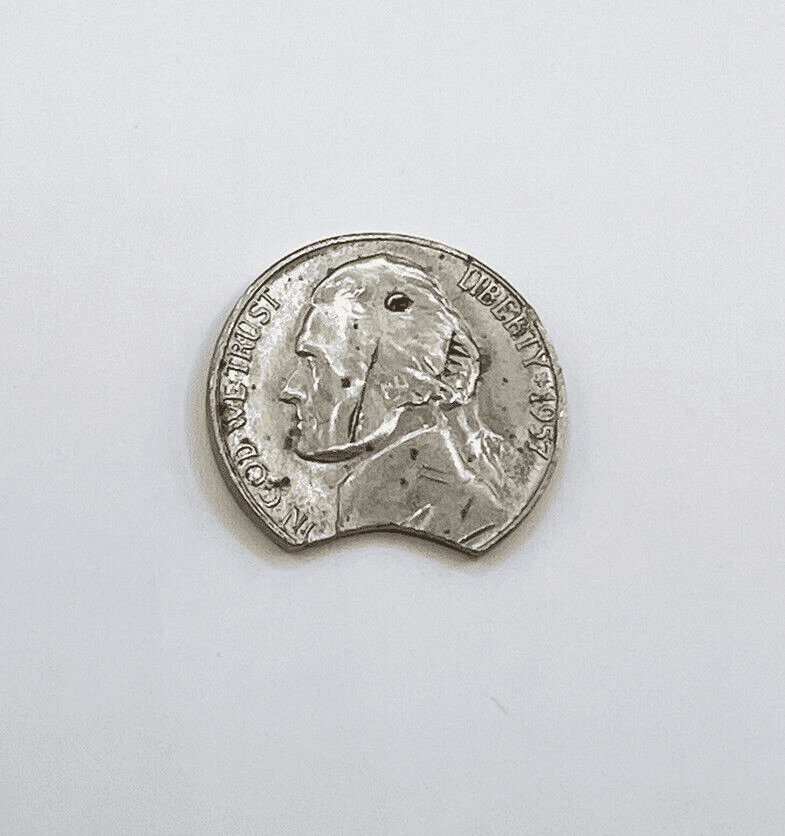
Strike-through error
Sometimes, a foreign object gets stuck on the planchet or die. When the die hits the planchet, the die strikes through the foreign object.
How the strike-through error will manifest itself would be a case-to-case basis. Sometimes, some distortion would happen on the coin. However, in this example, the strike-through error caused the foreign object to get buried or engraved on the coin.
Notice the shiny black portion on Jefferson’s head. That’s a foreign material that got stuck on the coin.
Off-center strike
Due to the misalignment of the die and planchet, the angle of the strike isn’t properly aligned. The degree of misalignment could determine how much of the coin is off-center.
Here’s a look at a mild off-center strike error on a 1957 nickel:
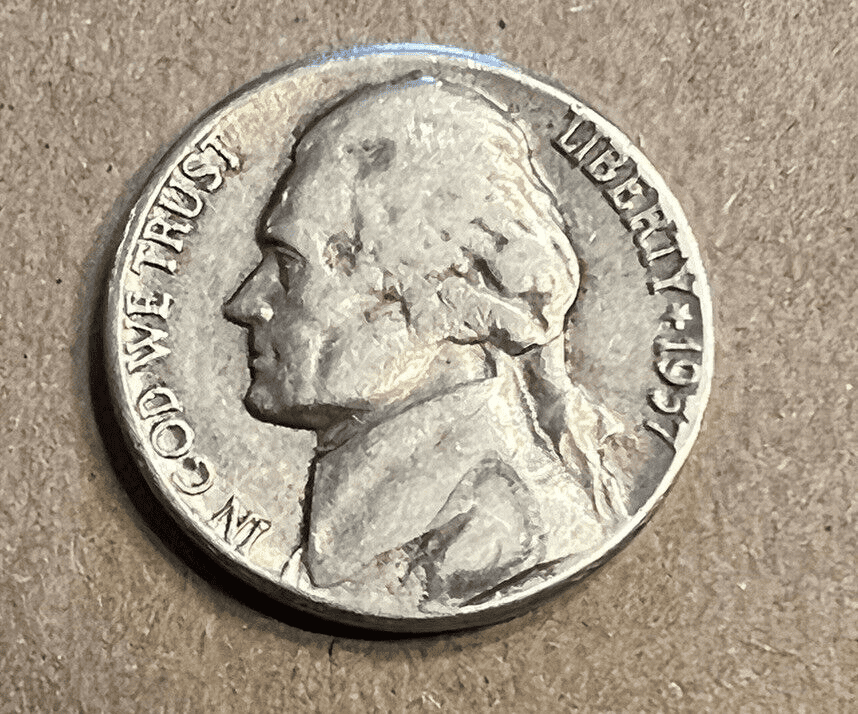
You’ll see in this example that the word LIBERTY and the year 1957 are already on the right-most edge of the coin. In some off-center errors, you’ll notice that some elements are even missing already.
How Much Is 1957 Jefferson Nickel Worth Today?
The 157 Jefferson nickel has a face value of 5 cents. It doesn’t have any precious metal in it so the melt value isn’t that far from its face value. At the time of this writing, the melt value is around $0.0656. Circulated 1957 Jefferson nickel is around $0.10 to $0.20.
Nevertheless, there are 1957 Jefferson nickels that are worth a lot of money. If it has rare characteristics and is still in good condition, it should be more valuable than its face value.
Here’s a table that shows you the auction records for each variety:
| Coin | Condition | Grade | Sold date | Sold by | Value |
| 1957 Proof Jefferson Nickel | Superb Gem Uncirculated | PR 68 – Deep Cameo | January 6, 2010 | Heritage Auctions | $7,475 |
| 1957 D Jefferson Nickel | Gem Uncirculated | MS 66+ – Full Steps | June 1, 2011 | Heritage Auctions | $4,600 |
| 1957 P Jefferson Nickel | Gem Uncirculated – Full Steps | MS 66 – Full Steps | June 1, 2006 | Heritage Auctions | $4,313 |
How Does The Grading System Work?
The 1957 nickel is graded using the Sheldon Scale, by looking at the coin’s luster, color, appearance, level of preservation, and quality of strike, an appraiser would give a numerical grade ranging from 1 to 70.
Aside from the numerical grade, adjectives are also attached to the grade. Some adjectives include Poor, Good, Fine, Uncirculated, and circulated.
There’s a special designation given to nickels. Looking at the reverse side of the coin, you’ll find stairs at the base of Monticello. An appraiser would count the noticeable number of steps in that stairs. If there are at least five steps found on the stairs, it would be called “Full Steps.”
A coin with a Full Steps designation means that the strike on the coin is superb and may command a higher premium.
Professional numismatists joined together in the 1970s and established CoinGrading standards. These numismatists now assign grades at key places on the seventy-point scale, using the most regularly utilized numeric points in conjunction with the original adjective grade. The following are the most common coin grades:
-
-
- (P-1) Poor – Indistinguishable and probably damaged; if used, must have a date and mintmark; otherwise, rather battered.
- (FR-2) Fair – Nearly smooth, but without the damage that a coin graded Poor often possesses. The coin must have enough detail to be identified.
- (G-4) Fair – Inscriptions have merged into the rims in some areas, and important elements have been mostly erased.
- (VG-8) Very Good- A little weathered, but all of the primary design elements are visible, albeit faintly. There is little if any, central detail left.
- (F-12) Good – The item is very worn, yet the wear is even, and the overall design details stand out clearly. Rims are almost completely isolated from the field.
- (VF-20) Very Fine – Moderately weathered, with some finer features still visible. The motto or all letters of LIBERTY are readable. Both sides of the coin have entire rims that are separated from the field.
- (EF-40) Extremely Fine – Gently used; all gadgets are visible, and the most important ones are bold. The finer details are bold and clear, however, light wear may be seen.
- (AU-50) Uncirculated – Slight evidence of wear on the coin’s design’s high points; may have contact marks; eye appeal should be adequate.
- (AU-58) Uncirculated Choice – Slight traces of wear, no severe contact marks, almost full mint shine, and great eye appeal.
- (MS-60) Mint State Basal – Strictly uncirculated; no indication of wear on the coin’s highest points, but an unsightly coin with reduced luster, visible contact marks, hairlines, and other flaws.
- (MS-63) Mint State Acceptable – Uncirculated, but with contact scratches and nicks, little reduced shine, but otherwise appealing appearance. The strike is weak to average.
- (MS-65) Mint State Choice – Uncirculated with great mint shine, very little contact blemishes, and exceptional eye appeal. The strike is unusually severe.
- (MS-68) Mint State Premium Quality – Uncirculated with superb luster, no obvious contact marks to the naked eye, and exceptional eye appeal. The strike is quick and appealing.
- (MS-69) Almost Perfect Mint State – Uncirculated with perfect brilliance, a sharp and appealing strike, and extremely good eye appeal. A near-perfect coin with minor imperfections in the planchet, strike, and contact markings (seen only under 8x magnification).
- (MS-70) Mint State Perfect – Under 8x magnification, there are no tiny imperfections discernible; the strike is crisp, and the coin is perfectly centered on a beautiful planchet. Rarely seen on a coin, this coin is bright and whole, with original luster and exceptional eye appeal.
-
Where To Buy Or Sell 1957 Jefferson Nickel?
You can buy or sell 1957 Jefferson nickels from the following:
- Online marketplaces – eBay, Amazon, and Etsy are known to have a wide range of coins for sale. You can even use these platforms to sell your 1957 Jefferson nickel. Simply create your own account for free and start buying and selling.
- Social media websites – Facebook, Twitter, and even YouTube can be a good place to sell your Jefferson nickel.
- Coin shops – coin shops specialize in selling and buying coins. So, there’s a good chance that you’ll find 1957 Jefferson nickels from these shops.
Be sure that you only transact with trusted and reputable vendors especially online.
FAQs
Is a 1957 nickel rare?
The 1957 nickel isn’t rare. You can easily find this in circulation or in coin shops. However, a 1957 nickel can become rare if it is still in great condition. Error coins can also be considered rare if they are unique.
How much is a 1957 nickel worth with no mint mark?
The no-mint mark 1957 nickel can be just available for less than a dollar. However, a nickel can dramatically increase its value if it is in good condition, especially if it is already officially graded. Just to give you an idea, a 1957 Proof Jefferson Nickel with a grade of PR 68 was sold for $7,475 in January 2010.
How do I know if my 1957 nickel is worth anything?
The best way to know if your 1957 nickel is worth anything is by having it graded by a professional grading service provider such as PCGS, NGC, or ANACS. Of course, you can also do your own assessment. Compare your 1957 nickel to other nickels and see if it has unique attributes or if it shows a beautiful and detailed surface.
